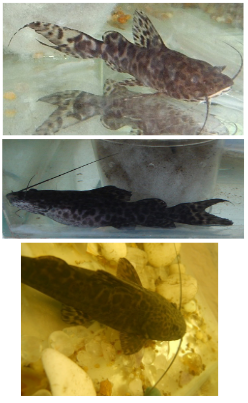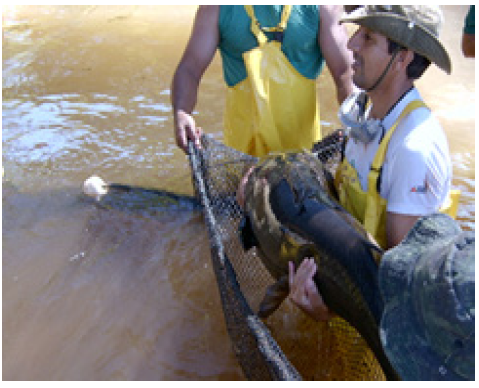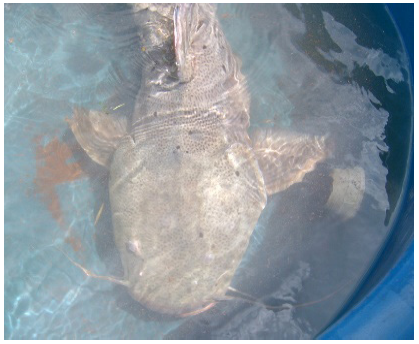International Journal of
eISSN: 2576-4454


Research Article Volume 6 Issue 1
1Instituto de Ciências Biológicas e Naturais, Universidade Federal do Triângulo Mineiro, Brasil
2Saneamento de Goiás – SANEAGO, Ouvidor, Goiás, Brasil
3Laboratório de Aquicultura e Ecologia Aquática, Universidade Federal do Vale do Jequitinhonha e Mucuri, Brasil
4Programa de Pós-Graduação em Ciências Ambientais. Universidade Federal de Alfenas
Correspondence: Afonso Pelli, Instituto de Ciências Biológicas e Naturais, Universidade Federal do Triângulo Mineiro, Av. Frei Paulino, 30; CEP 38025-180, Uberaba, MG, Brasil
Received: August 18, 2021 | Published: January 19, 2022
Citation: Pelli A, Lopes JM, Souza F, et al. Larviculture of the Zungaro jahu (Ihering, 1898) - JAÚ, an endangered species under laboratory conditions. Int J Hydro. 2022;6(1):14-18. DOI: 10.15406/ijh.2022.06.00297
Zungaro jahu (Ihering, 1898) is a fish threatened with extinction, according to the Red List of the Ministry of the Environment and Legal Amazon. The objective of this work was to propose a cultivation protocol for the jaú. In the laboratory, 54 larvae were cultured for 15 days. Six specimens of jaú were removed, with a survival rate of 11%. The estimated cost of the experimental unit was USD 62.50. With improvement of the cultivation system, we could achieve survival of 9 fingerlings, one for each experimental unit, at an average cost of $ 1.78 per fingerling. The authors believe that the cultivation of the jaú can be overcome, and they raise some hypotheses to justify the extinction in natural environments. Possible causes include changes in natural systems such as climate change, fishing, predation of juveniles by introduced species, diseases introduced, changes in food chains, limitation or restriction of habitat area, physical changes in the environment (formation of lakes for electricity generation), eutrophication or pollution from different sources. The development of larviculture protocols for this species would be an important tool to prevent the extinction, enabling at least its cultivation in the laboratory.
Keywords: conservation of species, siluriformes, fish farming
Fish does not serve only as a source of quality animal protein for man, but also as recreation and ornamentation.1,2 The Zungaro jahu (Ihering, 1898) belongs to the Order Siluriformes, Family Pimelodidae. It’s native of large rivers in the Midwest, Southeast and South of Brazil.3 It’s a predator of rheophilic habit, considered a large species, reaching about 1,5 meters and up to 150 kilos4,5 Z. jahu is commonly called "leather fish" or “jaú catfish” due to its body devoid of scales6 (Figure 1).

Figure 1 Young specimens of Zungaro jahu (Ihering, 1898) commonly called "leather fish" or “jaú catfish”; kept in captivity, in the vivarium of the Discipline of Ecology & Evolution of the Federal University of Triângulo Mineiro, in Uberaba/Minas Gerais.
Many fish in the Neotropical region have great potential for fishing and rearing. Despite their high reproductive capacity, many of these species are in the process of disappearing. Among them, the Siluriformes: Pseudoplatystoma corruscans (Spix & Agassiz, 1829) (Pintado), Pseudoplatystoma fasciatum (Linnaeus, 1766) (Cachára) and Zungaro jahu (Jaú), are known to have been greatly affected by anthropic impacts such as the destruction of their habitat, the pollution of their native rivers,7 impoundments8 and, most importantly, the transformation of the great rivers of the neotropical region into cascade reservoirs.4
The Zungaro jahu is an important large catfish that is in danger of extinction due to habitat destruction.9 Alves already considered it to be locally extinct in several stretches of rivers in the Grande and Paranaíba Basin due to cascading and reservoirs.10 According to Machado et al.11 135 endangered freshwater fish species are included into the Normative Instruction 05/04 and its amendments (Normative Instruction 52/05) all these belonging to the Actinopterygii. Seven other species take place in the overexploited or threatened with overexploitation category, such as Brachyplatystoma vaillantii (Valenciennes, 1840), Brachyplatystoma rosseauxii (Castelnau, 1855) and Jaú (Zungaro zungaro (Humboldt, 1821)), as well as the Arapaima gigas, the tambaqui (Colossoma macropomum (Cuvier, 1816)), two species of jaraqui, Semaprochilodus taeniurus (Valenciennes, 1821) and S. insignis (Jardine, 1841).
However, the Z. jahu was accidentally excluded from the official list, despite been on the list of endangered species elaborated by the Biodiversitas Foundation. Freshwater fish species considered to be threatened comprehend 5.9% of the fish species known in our fauna, but similarly to saltwater fish, this number can be dubious and probably underestimated since it's not possible to number all species and due to lack of adequate taxonomic knowledge.
The Red Book of Endangered Fauna of Paraná12 categorizes the Jáu Zungaru jahu (Ilhering, 1898) as vulnerable. Within the endangered species, Jaú is one of the three (Salminus brasiliensis, followed by Pseudopimelodus mangurus and Z. jahu), most abundant downstream from the Itaipu dam.13
Philippsen et al.14 indicates that in the Itaipu reservoir the fishing effort should not be increased for jaú (Z. jahu), due to significant drops in the volumes caught. As Jáu Z. jahu (Ilhering, 1898) is considered a vulnerable species by the National Red Book of Endangered Species, categorized in the Red Book of Threatened Fauna of Paraná,11,12 the cultivation of endangered species for the practice of repopulation has been an alternative to mitigate impacts. Therefore, the development of simple, original, and technically and economically viable systems have been conducted, often with different experimental objectives. In this sense, the production of pacamã Lophiosilurus alexandri,15 “surubim” Pseudoplatystoma reticulatum,16 and Pseudoplatystoma punctifer,17 which are also Neotropical carnivorous siluriformes, has been observed.
The objective of this work was to test the hypothesis that specimens of Jaú can be grown at an early stage for a low cost and to provide conditions for restocking studies. To test this hypothesis, the present work proposed to cultivate jaú with small infrastructure, aiming to establish minimum standards for the cultivation of the species.
This work was carried out at the Ecology and Evolution Laboratory of the Biological and Natural Sciences Institute of the Federal University of Triângulo Mineiro, in Uberaba / MG, in accordance with ethical standards and was approved by the Ethics Committee on Animal Use, process no 057/2016 UFVJM and 90/2009 UFTM.
The jaú fingerlings were donated by Energy Company of Minas Gerais, Hatchery Station of Volta Grande. In the laboratory, broodstock were weighed, marked, and conditioned in individual aquariums with aeration, continuous flow of water, and externally lined with dark canvas to reduce stress associated with management (Figure 2).




Figure 2 Management of adults’ specimens of Zungaro jahu (Ihering, 1898) commonly called “jaú catfish”; in Volta Grande Environmental Station at Conceição das Alagoas/Minas Gerais.
For reproduction of the fish, the prior dosage of gross carp hypophysis stratum was applied 48 hours before the first definitive dosage with the concentration of 0.3 mg / kg. The first preparatory dose was applied at a concentration of 3 mg / kg and the second dose at 6 mg / kg. The interval between these applications was 12 hours.
For extrusion, the fish were anesthetized with 0.08 g/L benzocaine. The o female’s oocytes were extruded into beakers and the semen distributed directly over it. The reproductive management of the matrices was performed considering the value of 220 degrees-hours for spawning.
Concomitantly, a 200 m2 tank, 1.2 to 1.4 meters deep, was prepared to produce plankton. It was fertilized with phosphate compounds (0.1kg/m2 of single superphosphate) and bovine manure (100 g/m2).
After fertilization, plots with 0.1 g of eggs/L were placed in 200-liter incubators. Fertilization rates (98%), hatching (85%), predation rate (25%) and loss due to transport and transfer to other environments (30%) were observed. The larvae hatched on Friday, November 30th, and on December 1st, they were transferred to aquariums with a volume of 1.9 liters (Figure 3).


Figure 3 Management of Zungaro jahu (Ihering, 1898) commonly called “jaú catfish during experimentation in the vivarium of the Discipline of Ecology & Evolution of the Federal University of Triângulo Mineiro, in Uberaba/Minas Gerais.
The Jaús weighting 1.02 ± 0.30 mg, and length 4.22 ± 3.5 mm, were distributed into nine black aquariums with 11.7 fish/aquarium, 6.14 fish/L, covered by a 50% shading screen, to soften the stress, with aeration (dissolved oxygen > 5.3 mg / L) and the temperature (26 ± 1.4 °C) kept constant, and the natural photoperiod.
Larvae were fed ad libitum with nauplii of Artemia sp., powder feed (550 g/kg crude protein), five newly hatched larvae of curimba Prochilodus lineatus /larvae, and wild plankton, on the first and second day. From days 3 to 13 of December, the larvae received powder feed (550 g/kg crude protein) and nauplii of Artemia sp. twice a day. From December 13th and 14th, was offered insect larvae (Nematocera, Culicidae, Culicinae). On December 15, the aliment was powder feed (550 g/kg crude protein) and 15 larvae of P. lineatus /larvae, and, on December 17 and 18, was offered powder feed (550 g/kg crude protein) and nauplii of Artemia sp. once a day.
On December 15 and 18, the aquariums were cleaned, siphoning 10% of the aquariums volume, which was replaced soon after.
At the end of the experimental period, fish were weighed with an analytical balance (0.01 g) and then measured, the total and standard length with a digital pachymeter (0.01 mm) after being anesthetized with Eugenol®. This solution was prepared with 5 mL of Eugenol and 95 mL of absolute alcohol; for each liter of water, 1 mL of this solution was added.
To calculate the juvenile unit value, the estimated cost of components was obtained in dollar, which were divided by the number of individuals obtained. The following material were used for cultivation: an air compressor pump for aquarium, Boyu U-2800 1.2 W ($15.00); silicone tubing to aquarium ($4.00); four aquariums with 2.5 liter; nine porous stones ($4.50); air splitters ($3.00); wood support ($3.00); artemia cysts ($1.00); powdered ration ($1.00); 1,000 larvae of P. lineatus ($5.00); energy consumption ($5.00); and hand labor (not accounted).
For the hatching of the artemia nauplii were used: incandescent lamp 40 W ($3.00), socket ($1.00), flex cable (2.5mm, 2 m) ($1.00), male plug 10 A ($1.00), sanitary water ($1.00), nauplii incubator ($5.00), net for cysts ($1.00).
The water temperature varied from 23ºC to 31ºC in all the experimental units during the period of December fourth to seventeenth. These values were adequate for the development of the species as they were compatible with those observed by Schneider et al.,18 studying creeks of a region of Paraná watershed, region of Jaú's natural occurrence.
Although the temperature has been shown to be adequate for the species, the best condition for its cultivation must be studied and adapted to each situation, since the temperature affects, in addition to the fish itself, environmental factors such as oxygen, salinity and exogenous food that will interact with the animal. In this sense, although high temperatures normally provide greater growth, lower temperatures that lead to a decrease in metabolism may be more appropriate when there is food and/or oxygen restriction.19 However, fish growth could be slowed or stopped if the temperature falls below the comfort range. On the other hand, when it is above this range, the growth rate tends to increase up to a ceiling, from when the growth decrease, it can become negative and even lethal.20
The effects of temperature interact with both environmental (oxygen, salinity, food supply) and intrinsic factors (age, population, lineage). Although some species in the natural environment show higher growth at elevated temperatures, this does not necessarily mean that temperature increase is an ideal condition for good fish production, since food availability and quality have a great influence on the metabolism of these animals. Thus, when food or oxygen are restricted, the temperature at which the fish grows better is lower than when food or oxygen is not limiting.19,20
The concentrations of dissolved oxygen (DO) during the study period ranged from 4.9 to 8.1 mg/L or 64 to 105% of saturation in all experimental units during the experimental period. The dissolved oxygen content considered ideal for most freshwater fish is above 5 mg/L (Furtado, 1995), and it's also like those observed by Schneider et al.18 in the region of Jaú's natural occurrence.
The estimated cost for the cultivation of the six fingerlings obtained in the process was: an air compressor pump for aquarium ($15.00); hoses ($4.00); 2.5 liter "pet" bottles; nine porous stones ($4.50); air splitters ($3.00); wood support ($3.00); artemia ($14.00); ration ($1.00); larvae of curimba ($5.00) and energy consumption ($5.00). The total estimated value was $54.50 to produce six jaú fish, that is, an approximate value of $9.08, each jaú fish.
Although the growth was well below expectations (the animals measured 1.2 – 2.0 cm in total length), the fish presents compensatory growth, that can be defined as a physiological process in which an organism accelerates its growth after a period of developmental restriction, generally due to the reduction of feed consumption, to reach the weight of animals whose growth has never been reduced.21-24 It can be used in fish feed management to improve its growth rate and consequently decrease production costs.
Compensatory growth is usually accompanied by hyperphagia, an increase in appetite and, sometimes, an increase in growth efficiency.21-24 Russell & Wootton24 reported that the compensatory growth mechanism is poorly understood. According to Pereira,3 because of jaú be a voracious ichthyophage; the Z. jahu captive breeding is very expensive. Could have the use of forage species as an alternative to its feeding since it is a good species for sport fishing, besides the refined taste of its meat.
The reproduction of jaú in laboratory is a way of preserving the species. Captivity is considered by several authors25,26 as an effective way of conserving biodiversity and can be used to provide demographic or genetic reserves, to increase existing natural populations, to establish new populations, or to provide a final refuge for species without hope of survival in nature.
Individuals from "ex situ" populations could eventually be released in the wild (a strategy already used by some electric utilities in Brazil) and studies on these populations should provide subsidies for the basic biology of the species and suggest new conservation strategies "in situ”.26 Captive populations that are sustainable may decrease the need to withdraw individuals from the environment to be displayed or for research purposes.
Captive-bred individuals can also help educate people about the importance of species conservation. On the other hand, "in situ" preservation is essential for the survival of species that are difficult to keep in captivity and to provide conditions for zoos, aquariums, and botanical gardens to continually present new species to public.
The survival rate was 11%; well above that reported in the literature in semi-intensive cropping system.27 The estimated cost of the experimental unit was $54.50, and in the second year, this cost would fall to $12.0, due to the permanent material that can be reused. With improvement of the cultivation system, we could achieve survival of 9 fingerlings, one for each experimental unit, at an average cost of $1.33 per fingerlings.
The laboratory cultivation of jaú proved to be adequate and promising, with favorable results for cultivation and at low cost. It can be a powerful tool for enhancement programs to avoid the extinction process to occur due to changes in the natural systems.
Starting from the premise that the cultivation of the Jaú can be overcome, it is verified that the extinction process occurs due to changes in the natural systems. The next step would be to identify which change is determining the process of population reduction: climate change; commercial, sporting or subsistence fishing; predation of young forms by species introduced into the basin; diseases introduced; changes in food chains; limitation or restriction of the appropriate habitat area; physical modifications of the environment, such as the formation of large lakes for electric power generation; eutrophication or pollution of different origin. Now, it is important to prevent the extinction of the species, making feasible, at least, the cultivation in the laboratory.
The authors are grateful to CEMIG for their logistical and financial support: P&D 208 - Companhia Energética de Minas Gerais (CEMIG) / Agência Nacional de Energia Elétrica (ANEEL).
The author declares there is no conflict of interest.

©2022 Pelli, et al. This is an open access article distributed under the terms of the, which permits unrestricted use, distribution, and build upon your work non-commercially.